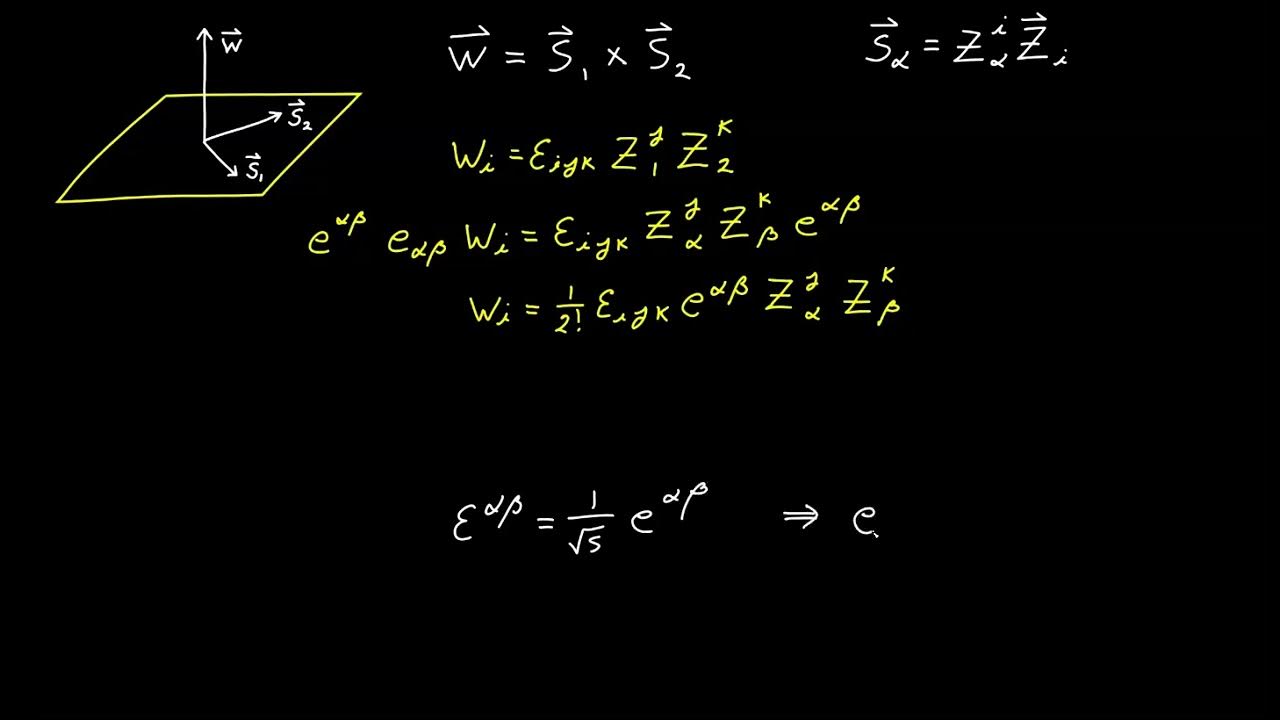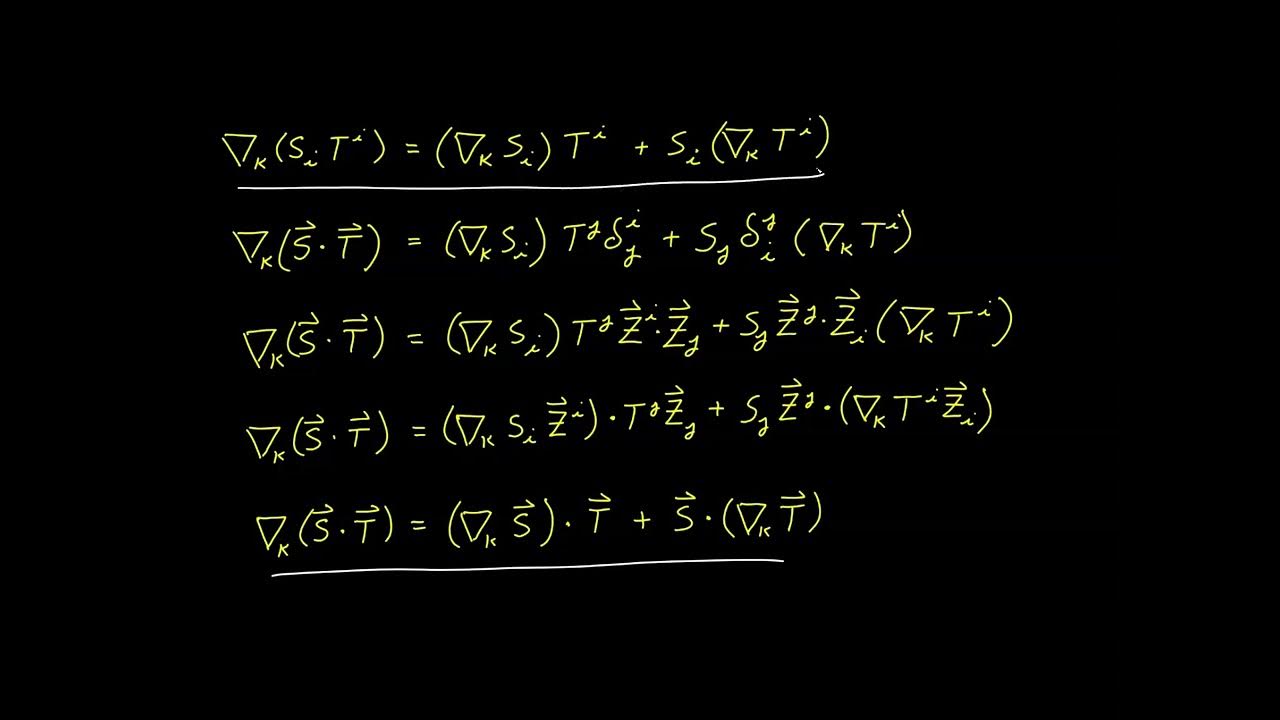Video 17 - Contravariant Basis
TLDRThis video delves into the concept of the contravariant basis in tensor calculus, a counterpart to the covariant basis introduced in a previous video. It begins by defining a new second-rank tensor, the contravariant metric tensor, as the multiplicative inverse of the covariant metric tensor. The contravariant basis vector is then derived, revealing its orthogonal and reciprocal properties when dot product operations are performed with the covariant basis vector. The video also discusses the symmetry of the contravariant metric tensor and how both basis vectors can be used to form linear combinations, emphasizing the invariant nature of vectors in different coordinate systems.
Takeaways
- 📚 Introduced the concept of a contravariant basis as the counterpart to the covariant basis in tensor calculus.
- 🔍 Defined a new second-rank tensor, the contravariant metric tensor, as the multiplicative inverse of the covariant metric tensor.
- 📐 Used the contravariant metric tensor to define the contravariant basis vector, which is also a set of linearly independent vectors.
- 📈 Explored the properties of the contravariant basis vector, including its orthogonality and reciprocal relationship with the covariant basis vector.
- 📝 Showed that the dot product of the contravariant basis vector with the covariant basis vector results in the Kronecker delta, indicating orthogonality when indices differ.
- 🔄 Demonstrated that the contravariant metric tensor is symmetric, similar to the covariant metric tensor, due to the commutative property of the dot product.
- 🧠 Discussed the implications of the contravariant basis vector for forming linear combinations and its equivalence to the covariant basis vector in representing vectors.
- 🔗 Highlighted that while the contravariant and covariant basis vectors are not equal, their linear combinations with appropriate scalar factors yield the same vector.
- 📚 Mentioned a theorem in linear algebra stating that if two vectors are inverses of each other and one is symmetric, the other must also be symmetric.
- 📘 Concluded with the understanding that the contravariant basis vector provides an alternate way to represent vectors, emphasizing the invariance of geometric objects.
- 🚀 Previewed the next video, which will provide examples of the contravariant basis in sample coordinate systems.
Q & A
What is the contravariant basis in the context of tensor calculus?
-The contravariant basis is a set of three linearly independent vectors that are defined using the contravariant metric tensor. It is the counterpart to the covariant basis and can be used to create linear combinations, just like the covariant basis vectors.
How is the contravariant metric tensor defined in relation to the covariant metric tensor?
-The contravariant metric tensor is defined as the multiplicative inverse of the covariant metric tensor. When these two tensors are multiplied together, they produce the Kronecker delta, which is equivalent to the identity matrix.
What property does the contravariant basis vector possess due to its definition?
-The contravariant basis vector possesses the contravariant property because its indices are in the upper position. This is a characteristic of tensors with upper indices.
How does the dot product of the contravariant basis vector with the covariant basis vector relate to the Kronecker delta?
-The dot product of the contravariant basis vector with the covariant basis vector results in the Kronecker delta. This means that for i not equal to k, the dot product is zero, indicating orthogonality, and for i equal to k, the dot product is one, indicating that the vectors are reciprocals of each other.
What does it mean for the contravariant and covariant basis vectors to be orthogonal to each other?
-Orthogonality between the contravariant and covariant basis vectors means that the dot product of any two vectors where the indices are not equal results in zero, indicating that the vectors are perpendicular to each other in the given basis.
Why is the contravariant metric tensor symmetric?
-The contravariant metric tensor is symmetric because the operation of dotting two vectors is commutative. This commutative property necessitates that the tensor must be symmetric, allowing the indices to be flipped without changing the result.
How can the contravariant basis vector be used to express a linear combination of vectors?
-The contravariant basis vector can be used to express a linear combination by multiplying it with a covariant component. This linear combination will yield the same vector as when using the covariant basis vector multiplied by a contravariant scalar factor.
What is the significance of the contravariant basis vector being able to form the same linear combination as the covariant basis vector?
-The ability of the contravariant basis vector to form the same linear combination as the covariant basis vector signifies that both sets of basis vectors can represent the same vector space. This is important for understanding the geometric properties of vectors in different coordinate systems.
How does the contravariant basis vector relate to the covariant basis vector in terms of their components?
-While the contravariant basis vector and the covariant basis vector are not equal to each other, and their components are not equal, the linear combinations they form with appropriate scalar factors result in the same vector, reflecting the invariant nature of geometric objects.
What is the Kronecker delta and how does it relate to the identity matrix?
-The Kronecker delta is a tensor that has a value of 1 when its indices are equal and 0 when they are not. It is equivalent to the identity matrix because when used in matrix multiplication, it does not change the other matrix, just as the identity matrix does.
Outlines
📚 Introduction to Contravariant Basis
This paragraph introduces the concept of a contravariant basis, which is a counterpart to the covariant basis discussed in a previous video. It defines a new second-rank tensor using the contravariant metric tensor and the Kronecker delta. The contravariant basis vector is shown to be the multiplicative inverse of the covariant metric tensor, resulting in an identity matrix when multiplied together. The properties of this new vector are explored, including its orthogonality and reciprocal relationship with the covariant basis vector, as demonstrated through dot product calculations.
🔍 Properties of Contravariant and Covariant Basis Vectors
The second paragraph delves deeper into the properties of the contravariant basis vector, highlighting its orthogonality and reciprocal relationship with the covariant basis vector when their indices match. It also discusses the dot product of the contravariant basis vector with itself, leading to the discovery that the newly defined contravariant metric tensor is symmetric, mirroring the properties of the covariant metric tensor. The paragraph emphasizes the commutative nature of the dot product and its implications for the symmetry of both metric tensors.
🌐 Applications of Contravariant Basis in Linear Combinations
The final paragraph discusses the application of the contravariant basis in forming linear combinations, paralleling the process used with the covariant basis. It explains that while the contravariant and covariant basis vectors are not equal, and their respective components differ, the linear combinations they form yield the same result. This invariant representation of a vector is crucial for understanding the geometric relationships in tensor calculus. The paragraph concludes by previewing the next video, which will showcase the contravariant basis in sample coordinate systems.
Mindmap
Keywords
💡Covariant Basis
💡Contravariant Basis
💡Metric Tensor
💡Second Rank Tensor
💡Inner Product
💡Orthogonality
💡Kronecker Delta
💡Symmetric Tensor
💡Linear Combination
💡Invariant
Highlights
Introduction of the contravariant basis concept as the counterpart to the covariant basis.
Definition of a new second-rank tensor using the covariant metric tensor and the Kronecker delta.
Explanation of the contravariant property due to the upper position of the indexes in the tensor expression.
Creation of an inner product resulting in a dummy index, leading to the inverse relationship between two tensors.
The new tensor is identified as the multiplicative inverse of the covariant metric tensor.
Definition of the contravariant basis vector using a set of linearly independent vectors.
Dot product of the contravariant basis vector with the covariant basis vector results in the Kronecker delta.
Orthogonality of the contravariant and covariant basis vectors except when their indices match.
Dot product of the contravariant basis vector with itself yields the contravariant metric tensor.
Symmetry of the contravariant metric tensor is demonstrated through the dot product.
The contravariant basis vector can be used to form linear combinations with covariant components.
Equivalence of expressing a vector using either the covariant or contravariant basis vectors.
The contravariant and covariant basis vectors are not equal, but their linear combinations yield the same result.
The contravariant metric tensor is defined as the matrix inverse of the covariant metric tensor.
Properties of the contravariant basis vector are explored, including its orthogonality and reciprocal relationship.
The contravariant metric tensor is found to be symmetric, similar to the covariant metric tensor.
Practical application of the contravariant basis in forming linear combinations equivalent to those formed with the covariant basis.
The contravariant basis provides an alternate representation of vectors, emphasizing the invariant geometric nature of vectors.
Upcoming video will include examples of the contravariant basis in sample coordinate systems.
Transcripts
5.0 / 5 (0 votes)
Thanks for rating:





